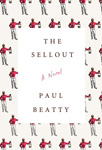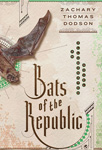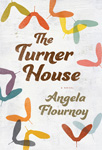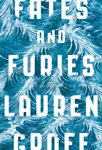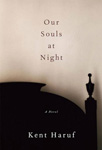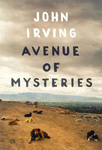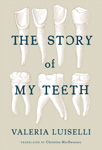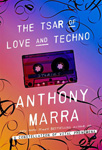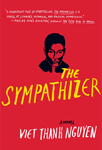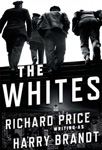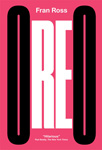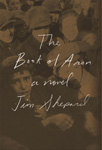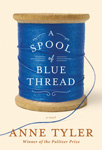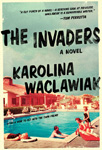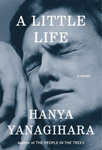by Chris Adrian and Eli Horowitz
Buy it at Powell’s »Jaime Green: Once I was about 50 pages into Bats of the Republic, I was relieved. Not that the book was good, though it was, and I knew this would make my decision harder. No, I was relieved that this book was so weird. I hadn’t read either of these books before my judging, but I had heard a lot about The Turner House. Angela Flournoy has been winning awards and acclaim for the last year, and the only thing I wanted less than to have The Turner House trounce its competition was to face an apples-to-apples, wonderful-novels decision. Luckily, this is apples-to-oranges, or apples-to-prickly-pear, which is much more interesting for all of us!
Bats of the Republic swings a steam-powered hammer at the very frame of what a novel is. Yet at the same time, its exquisite design, down to copyright page, down to the inside of the dust jacket, reminds us that a novel is traditionally a paper-and-ink object. This is a work that is highly concerned with aesthetics.
The narrative is built of interlocking archives—letters, novels, transcripts, and illustrations—which isn’t in itself revolutionary, but there was one moment that promoted Bats from “neat tricks” to me saying, “What. WHAT!” out loud to the book in my hands. By this point, I’d met Zeke and Eliza in 2143 Texas in the section called The City-State; Henry Bartle in his letters to Eliza; and Zadock Thomas in 1843 through his letters to Elswyth Gray. Then, in the first section from The Sisters Gray, the novelization about Elswyth and her sister Louisa that Bartle is apparently giving to Eliza, the sisters discuss their deceased mother’s book:
“Will you read from Mother’s book?” Louisa asked upon their return. She never tired of listening to someone read from the stack of pages that made up their mother’s novel.
“The City-State is tiresome to read, Louisa, it has too many devices and made-up words.”
And I was like

Until that point, I’d been reading The City-State as our neutral ground-zero, the “true” or “real” narrative from which everything else spun off. So when I discovered that it itself was a novel, that there was no solid ground and the whole thing was a Möbius strip of references and inventions, I felt like we were in dangerous, exciting, new territory.
Please don’t tell me if this isn’t actually original or new, or if Marcel Duchamp did this a hundred years ago. I was excited while I was reading this book.
I realized later that I had missed the signal of The City-State’s title page, with author E. Anderson and subtitle “Novelty of Future Times.” When I had flipped past that page I was but a babe, naive to the world of Bats of the Republic, unaware that every page and annotation was a clue.
But a clue TO WHAT?
The mystery in this book isn’t the narrative—the characters are too intentionally flat for that, too subservient to the machinations of structure. Sure, I wondered what would happen to Zeke and Eliza and, a bit less so, to Zadock and Elswyth, but my real, gnawing curiosity was about the intertextuality and collage, how the parallel narratives of Zeke and Zadock would converge.
The one narrative curiosity I had was about Zeke and Zadock’s unopened letters. (Or was it the same, single letter?? Aaaah!!) The promise of payoff—and thus the demands of that payoff—felt huge.
Well. After 441 mostly riveting pages, it was the first time I felt really let down. But 441 pages of successfully, excitingly doing things I’ve never really seen a novel do—that’s not canceled out by the lack of a thunder-crash ending.
The Turner House, on the other hand, does nothing to push the limits of the form of “the novel.” It just does the things a novel does extraordinarily, mind-blowingly well.
Reading The Turner House felt like surrender, like lying back into a current and being carried along. The plot pulls you, sure: What will happen to the Turner house in 2008, how will Francis and Viola reconcile in 1944? Lelah’s gambling, Cha-Cha’s marriage, Lelah’s sudden romantic fling. But those are almost MacGuffins to make room for the characters—these extraordinary, complex concentrations of humanity.
Where the characters in Bats were almost beside the point, the characters in The Turner House are the book’s beating heart and its engine. No one is simply good or bad; no one is simple at all.
Like Bats, The Turner House opens with a family tree, and the Turner tree is super intimidating, what with Francis and Viola having had 13 kids. At first I couldn’t keep anyone straight, but I decided, rather than gripping tight to that map, to try trusting that the book would take care of me. And sure enough, important characters started to stand out in clearer relief, so completely themselves that I could hear them through the cacophony and chorus.
And that cacophony is as wonderful as the clear-voiced solos. Scenes with almost a dozen characters wash over you, but you never drown. In this rich, sprawling last scene, the Turner family exerts so much gravity that even the third-person narration seems pulled into its orbit:
There truly ain’t no party like a Turner house party. Like a single-celled organism, it can change shape and reproduce itself with little fuel. The food runs out by 9 p.m., no matter how much they make, but the booze never ends. … Every Turner dances, two left feet or no.
Angela Flournoy’s acknowledgements begin with her thanking her aunties “for showing me that families are their own universes worthy of exploration,” and that’s exactly the marvel that’s been accomplished here. Family, humanity, and the city of Detroit are honored in all their complexity.
The Turner House and Bats of the Republic are trying to do completely different things, and I loved reading both of them. Bats of the Republic is inventive, innovative, and daring. The Turner House is sensitive, generous, and subtle. Bats reaches far; Turner House reaches deep.
The only thing in the intersection of what these books could both have aimed for is richness. And only one of them achieved it. Bats of the Republic is an engrossing puzzle, but even formally innovative work has the potential to make us feel things deeply, and that potential, here, wasn’t fulfilled.
A Möbius strip is all surface, after all.
I loved the experience of reading Bats of the Republic, but I love The Turner House, and that’s the difference.
Match Commentary
By Kevin Guilfoile & John Warner
Kevin: Not a surprising verdict, John, not even for me. I have made my admiration for Bats of the Republic known throughout these commentaries, but The Turner House is an effortless gem of a novel. You really care very deeply about Flournoy’s characters, and the portrait of Detroit, which is still recovering slowly from the financial crisis that unfolds in the book, is moving and timely. It’s become a cliché to say that an author has turned a setting into a character—setting doesn’t need to take a back seat to anyone, but Flournoy’s characters make an important twenty-teens argument on behalf of that city.
Judge Green makes the point that, as different as these two books are, they both share the DNA of the family saga. The novel that The Turner House most resembles, though (and in fascinating ways) is A Spool of Blue Thread. They are both melodramas about several generations of families—one black and urban, one white and rural—with an identical framing device, a house that has become the center of gravity for each clan over the decades. In a way they are sort of Arthur Miller/working-class American versions of Downton Abbey. (That’s totally a stretch, but I just watched the DA finale and I’m very emotional. Bates has a son!)
For anyone trolling the ToB for book-club ideas, I highly recommend reading the Tyler and the Flournoy novels back to back. Each story has a similar authenticity, and they are both easy to like. I promise your neighbors won’t hate you for making them read either one.
John: As I read The Turner House, when we are confronted with a character about to make a bad decision, I would fervently wish they not make that bad decision, and if/when they made that decision, I would feel that visceral pain for them.
These people are invented, nonexistent, and yet in that moment they become real, more than real, as I had internalized their experience. This is not all that mysterious, as it’s simply the experience of empathy, a well-known byproduct of reading. But what an amazing alchemy. I would say that The Turner House is more successful at this than A Spool of Blue Thread, where I never quite lost the sense that I was inside an Anne Tyler novel, a pleasant place to be for sure, but something different.
And Bats of the Republic never took me anywhere close to that experience. It just didn’t seem designed for that particular pleasure. The pleasures one looks for in reading (these pleasures often being subconscious) drive our responses to these texts. My interest in the pleasures of Bats of the Republic is limited. For The Turner House, my interests are nearly bottomless, a 7-Eleven Ultra-Mega Gulp.
I commend Bats on its run, but to me The Turner House is looking like a real threat.
Kevin: Do you know what else The Turner House has, John? Detroit-area casinos! You and I were driving from Toronto back to Chicago once and we stopped for blackjack and sandwiches at a casino in Windsor, just across the Canadian border from Detroit. In about half an hour we were both down probably 50 dollars so we got up to leave and I dropped my last loonie in a slot machine by the parking garage and BOOM! It hit for like 300 bucks! An entire trip’s worth of gas and snacks paid for. To this day that remains the only slot machine I have ever given money to. Whatever else fails to go my way in life, slot machines are my Reek.
John: Though, at the time, the exchange rate was reasonably similar to today, and the weak Canadian dollar meant that the $300 Canadian was like $60 American plus a Strange Brew DVD thrown in for good measure.
Kevin: I should also disclaim that the casino scenes in The Turner House are generally not as pro-gambling as my commentary just was.
Bats of the Republic does not have enough Zombie fuel to bring it back to life, so unfortunately we will say goodbye to it here. I do hope its little run at the Rooster has placed it on a few more nightstands, though. I think it’s a fun book, a real pleasure to explore. But if the Zombie Round were held today (and it almost is) Fates and Furies and A Little Life would still be our foot-dragging flesh eaters.
Monday we’ll step out of the booth to make room for Michael Schaub and Janet Potter, hosts of The Book Report. On the card we will feature The Sellout and The Tsar of Love and Techno, with novelist and Rooster veteran Jeff VanderMeer putting the powder in his wig.

The official 2016 Tournament of Books T-Shirt by book designer Janet Hansen. Order yours!



